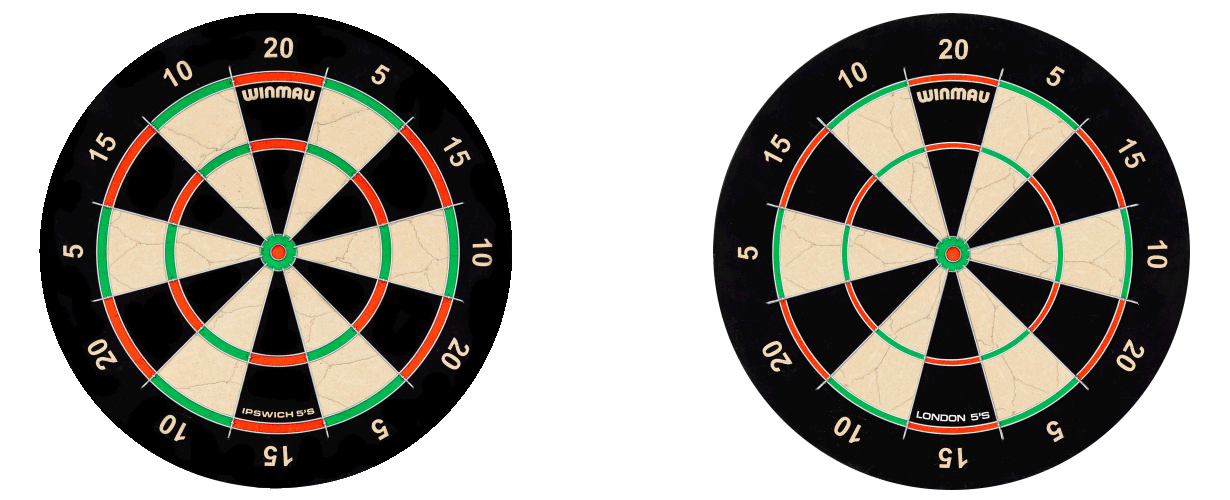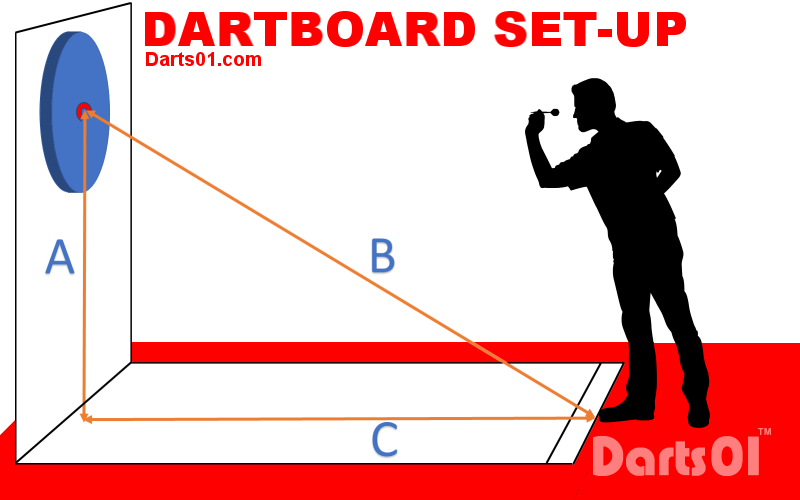Fives Dartboard
London & Ipswich Fives | Narrow & Wide Fives
London 'East End' 5's
The Fives dartboard is a rare site these days. The board is made up of twelve segments each with a double and treble plus an inner and outer Bull. The main game being 505 instead of 501. The two fives boards differ slightly. The London Fives having narrower double and treble scoring segments than that of the Ipswich Fives. The boards are also called ‘Narrow Fives’ and ‘Wide Fives’. And the London Fives is in some cases also referred to as the ‘East End’ Fives
The Fives board would have been regularly seen in the East End of London, however, few still use it. The so-called standard dartboard is also called the London board and, in some cases, referred to as a clock board; or could this be a reference to the London Five? The Fives Dartboard has twelve set scoring areas hence to say the same as twelve numbers on a clock face but the reference to a clock board In the Guinness Books of Darts by Derek Brown refers the ‘Clock’ / ‘London’ board the board we refer to as the standard board of today. I leave you all to ponder!

Ipswich Fives (Wide Fives) Dartboard and London 'East End' Fives (Narrow Fives) Dartboard
![]()
London Five's Dartboard Set-up and Rules:
Details given from East London Darts League show the following dartboard set-up details:
The Board should hang securely from a wall so that the height of the centre bull is 5ft 6ins from the floor.
The throwing distance is 9ft from the face of the board measured horizontally. This equates 10ft 6ins when measuring from the Centre Bullseye to the rear of the oche.
The toe-line or oche shall be clearly marked and should be at least 18ins long. The toe line can be just a painted line on the ground or a securely raised line indicator such as a piece of wood or metal. The latter is preferable as the thrower has a firm edge to rest his/her foot against.
I believe the Ipswich Fives dartboard set-up is the same as the London Fives.
| A: Height to Centre Bull | B: Centre Bull to Oche | C: Throw Distance |
| 5ft 6ins / 1.676m | 10ft 6ins / 3.20m | 9ft / 2.743m |

![]()
Rules / Games 305, 505, 705, 805, 0r 1,005
The order of play is either determined by a toss of a coin or by each player throwing for the centre bull the nearest being the player that throws first. The rules here can vary depending on the league you may be playing in; the local rules should be observed at all times.
When throwing for the bull, if the first thrower hits the centre bull or outer bull the dart is usually removed before the second player throws. If the second player hits the same as the first player then the bulling-up procedure starts again. If the first player's dart does not hit either the centre bull or outer bull then the dart remains in the board until the second player throws. If the first player's dart is obstructing the bull the second player may request the marker/ref to straighten the dart. (See local rules)
Once the order of play has been determined the winner will start leg one and odd legs after that. The loser will start leg two and even legs thereafter.
Any standard darts may be used.
A throw consists three darts except were the game is finished in less.
Darts cannot be re-thrown this includes darts that miss the board and darts that bounce of the board wiring system. Only darts that have their points touching the scoring area of board score.
A player may be told, if he asks, what number they scored, or what number he requires for the game, by the score announcer, but not how to get it.
If the number required for the game is exceeded in the course of a throw, throw ceases, and no account is taken of the score obtained during that throw.
The bullseye (50) and outer-bullseye (25)
The game is to score 305, 505, 705, 805 or 1,005 as previously agreed.
The game is played as per the standard 501 games except the starting number ends in a 05 not 01.
Scoring
Generally, each player’s score must start and finish a game with a double (The narrow outer ring of the board). Competition games, however, are usually played with a straight start (no compulsory double) but with a compulsory double to finish.
The first throw is deducted from the player's start number e.g. 505 and then from the subsequently reduced total. The scorer should show both the score obtained for the throw and the reducing total remaining.
For fast Practice games play 305. For competition 505 and for pairs usually 705. In fact, any agreed starting number can be used but usually, the number should end 05.
If you are playing in a league always refer to the league rules as these can differ by area and league.
Acknowledgements | Privacy, Cookies & Terms of Use | FAQ


